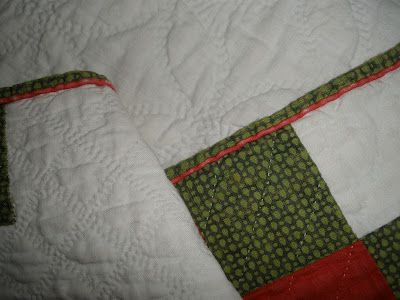I have two vintage red and green quilts from the mid-1800's. They will time-share the guest room bed for the holidays; each getting about a week to be on-stage. Both are old enough, and fragile enough, that they need to be removed if someone is going to use the bed.
 |
| 88" x 88" |
The Irish Chain done in plain white, turkey red and a green print is a simple graphic delight; one of the very earliest pieced quilt designs.
It's densely hand quilted and has red piping in the binding, a treatment most common between 1840-1880 according to Barbara Brackman in Clues in the Calico.

Straight lines are quilted through the 'chain'.
Here you can see the piping, all fabrics and all quilting motifs.
When I first laid it on the bed I noticed that there was a greenish tinge to the background fabric. It's been used and washed in its life but probably stored for many years. The most likely explanation is that the green print had 'crocked' - not bled or run - but rubbed off, onto the creamy white. It bothered me. But this is an OLD quilt. Washing it would be a real risk. I needed to give this some serious thought.
After several years - yes really - I decided to take the risk. I was aware that I could ruin it but whatever happened it would be a learning experience and I was not happy with it the way it was.
I use my top-loading washer leaving the lid open. With the diluted Orvus soap and water already in the machine, I gently immerse the quilt and move it up and down by hand - I do not let the machine agitate. After it sits awhile I gently push it up and down again.
The water quickly turned almost black! I drained that water, refilled the tub and repeated the process.
After rinsing in clear water one or two times I use the gentlest spin - positioning the textile at the outer edges of the tub to minimize pressure on it. Removing the excess water is important as the stitches and fabrics are even more fragile when wet and heavy.
I then carefully remove it, blot it gently with large clean white towels and lay it flat to dry; first out on our deck but then on the grass with a clean sheet under it. I also put a clean sheet over the top and weight it down to avoid accidents with birds or other debris in the air but for the photo I took it off.
Ta-Da! Success. The green tinge was gone - the quilting really stood out and the quilt was clean. If there was slight loss in some of the turkey red fabric, which was quite worn to start with, the overall look and removing the soil and the greenish tinge made that worth it to me.
I advocate careful methods and due consideration before washing any older quilt but I also believe that storing a 'dirty' quilt is not good for it. Luckily, in this case, I had good results!
 |
| Center Stage - What a show off! |
Coming Soon: Red and Green II - An Applique




oh what a beautiful quilt and I LOVE the quilting.
ReplyDeleteI am so glad you had positive results with washing the quilt!
thank goodness!
Kathie
This is a quilt that makes my heart go pitty-pat! I'm with you... careful washing is sometimes called for. Do you use the color catcher sheets in the water to keep the fabrics that might run from getting on each other? They are nice insurance when washing any quilt. I get mine in the laundry aisle.. they are made by Shout if I recall correctly.
ReplyDeleteIt looks even better all spiffed and fluffed. Glad for your success. It looks like it was worth it.
ReplyDeleteYes. I do use those dye catcher sheets - mostly with newly made quilts. If a vintage quilt appears to already have been washed I don't worry so much about the dye issues. With new quilts even though I always prewash everything - I still often have excess dye. Also, I don't leave the room for long - I check that water by dipping a pure white plastic cup - they you can see if the water is coloring.
ReplyDeleteSo glad that the washing was a good idea. Wow, that water was dark!
ReplyDeleteI love your washing instructions. I've done that myself with a couple of old quilts and also had good results.
ReplyDeleteLove the quilting on this one - another of your treasures ;-)
ReplyDeleteLooking forward to the next one too.
Thank you for sharing
Congratulations on a successful washing experience. I, too, have machine washed dirty old quilts. Twice. Both times the quilts survived just fine. And, because they were so completely awful, I didn't hesitate to agitate. I couldn't stand them in my house otherwise.
ReplyDeleteJean, I have been so tempted to do this but I have such hard well water that leaves residue on everything, one way or another, that I am afraid to try it on anything but the worse quilts that actually stink. I think the only thing I could possibly do is buy a new kiddy wading pool and buy gallons of water with which to fill it. Unless someone has a suggestion of how I can treat hard well water to make it safer for washing quilts!
ReplyDeleteGood for you!!! I believe in washing old quilts and I love that you had the courage to do it!!....this is such a beautiful quilt and so much the better for being clean. I love it! the quilting is amazing
ReplyDeleteTim